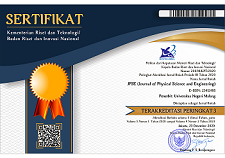Pembuatan DSSC dengan fotoanoda dari TiO2 dan β-karoten sebagai sensitizer dan Analisis kurva I-V
Abstract
Keywords
Full Text:
PDFReferences
E. Gençer and R. Agrawal, “A commentary on the US policies for efficient large scale renewable energy storage systems: Focus on carbon storage cycles,” Energy Policy, vol. 88, pp. 477–484, 2016.
M. Arshad and S. Ahmed, “Cogeneration through bagasse: A renewable strategy to meet the future energy needs,” Renew. Sustain. Energy Rev., vol. 54, pp. 732–737, 2016.
M. A. Green, K. Emery, Y. Hishikawa, W. Warta, and E. D. Dunlop, “Solar cell efficiency tables (version 46),” Prog. Photovoltaics Res. Appl., vol. 23, no. 7, pp. 805–812, 2015.
B. O’regan and M. Grätzel, “A low-cost, high-efficiency solar cell based on dye-sensitized colloidal TiO2 films,” Nature, vol. 353, no. 6346, pp. 737–740, 1991.
M. Grätzel, “Dye-sensitized solar cells,” J. Photochem. Photobiol. C Photochem. Rev., vol. 4, no. 2, pp. 145–153, 2003.
K.-H. Park, S. J. Kim, R. Gomes, and A. Bhaumik, “High performance dye-sensitized solar cell by using porous polyaniline nanotubes as counter electrode,” Chem. Eng. J., vol. 260, pp. 393–398, 2015.
H. M. Upadhyaya, S. Senthilarasu, M.-H. Hsu, and D. K. Kumar, “Recent progress and the status of dye-sensitised solar cell (DSSC) technology with state-of-the-art conversion efficiencies,” Sol. Energy Mater. Sol. Cells, vol. 119, pp. 291–295, 2013.
Y. Shi et al., “Solid-State Synthesis of ZnO Nanostructures for Quasi-Solid Dye-Sensitized Solar Cells with High Efficiencies up to 6.46%,” Adv. Mater., vol. 25, no. 32, pp. 4413–4419, 2013.
H.-R. An, H. An, D.-H. Riu, and H.-J. Ahn, “Improved Photovoltaic Properties Of Dye-Sensitized Solar Cells Using Laser Patterned F-Doped SnO2 Thin Films,” Arch. Metall. Mater., vol. 60, no. 2, pp. 1241–1245, 2015.
A. A. Khan, J. Islam, S. G. Ansari, H. Fouad, and Z. A. Ansari, “Effect of neodymium on the photoconversion efficiency of TiO2 based dye sensitized solar cells,” J. Mater. Sci. Mater. Electron., vol. 26, no. 3, pp. 1737–1742, 2015.
K.-N. Li, Y.-F. Wang, Y.-F. Xu, H.-Y. Chen, C.-Y. Su, and D.-B. Kuang, “Macroporous SnO2 Synthesized via a Template-Assisted Reflux Process for Efficient Dye-Sensitized Solar Cells,” ACS Appl. Mater. Interfaces, vol. 5, no. 11, pp. 5105–5111, 2013.
M. R. Narayan, “Review: Dye sensitized solar cells based on natural photosensitizers,” Renew. Sustain. Energy Rev., vol. 16, no. 1, pp. 208–215, 2012.
K. I. Ishibashi, Y. Kimura, and M. Niwano, “An extensively valid and stable method for derivation of all parameters of a solar cell from a single current-voltage characteristic,” J. Appl. Phys., vol. 103, no. 9, pp. 2–7, 2008.
M. Caglar, S. Ilican, and Y. Caglar, “Influence of dopant concentration on the optical properties of ZnO: In films by sol–gel method,” Thin Solid Films, vol. 517, no. 17, pp. 5023–5028, Jul. 2009.
J. I. Pankove, Optical processes in semiconductors. Courier Corporation, 2012.
A. H. Kurda, Y. M. Hassan, and N. M. Ahmed, “Controlling Diameter, Length and Characterization of ZnO Nanorods by Simple Hydrothermal Method for Solar Cells,” World J. Nano Sci. Eng., vol. 5, no. 1, p. 34, Feb. 2015.
D. Sengupta, P. Das, B. Mondal, and K. Mukherjee, “Effects of doping, morphology and film-thickness of photo-anode materials for dye sensitized solar cell application – A review,” Renew. Sustain. Energy Rev., vol. 60, pp. 356–376, Jul. 2016.
K. E. Jasim, “Solar Cells - New Approaches and Reviews,” in Dye sensitised solar cells—working principles, challenges and opportunities, InTech.
A. Ortiz-Conde, F. J. García Sánchez, and J. Muci, “New method to extract the model parameters of solar cells from the explicit analytic solutions of their illuminated I-V characteristics,” Sol. Energy Mater. Sol. Cells, vol. 90, no. 3, pp. 352–361, 2006.
C. Zhang, J. Zhang, Y. Hao, Z. Lin, and C. Zhu, “A simple and efficient solar cell parameter extraction method from a single current-voltage curve,” J. Appl. Phys., vol. 110, no. 6, p. 64504, Sep. 2011.
J. D. Servaites, S. Yeganeh, T. J. Marks, and M. A. Ratner, “Efficiency Enhancement in Organic Photovoltaic Cells: Consequences of Optimizing Series Resistance,” Adv. Funct. Mater., vol. 20, no. 1, pp. 97–104, Jan. 2010.
N. Koide, A. Islam, Y. Chiba, and L. Han, “Improvement of efficiency of dye-sensitized solar cells based on analysis of equivalent circuit,” J. Photochem. Photobiol. A Chem., vol. 182, no. 3, pp. 296–305, Sep. 2006.
H. J. Snaith, L. Schmidt-Mende, M. Grätzel, and M. Chiesa, “Light intensity, temperature, and thickness dependence of the open-circuit voltage in solid-state dye-sensitized solar cells,” Phys. Rev. B, vol. 74, no. 4, p. 45306, Jul. 2006.
J.-J. Huang, S.-P. Chiu, M.-J. Wu, and C.-F. Hsu, “Effect of titanium oxide compact layer in dye-sensitized solar cell prepared by liquid-phase deposition,” Appl. Phys. A, vol. 122, no. 11, p. 971, Nov. 2016.
A. Scuto et al., “Improvement of DSSC performance by voltage stress application,” in 2016 IEEE International Reliability Physics Symposium (IRPS), 2016, p. PV-3-1-PV-3-6.
Copyright (c) 2018 Thathit Suprayogi, Dina Maftuha, Markus Diantoro

This work is licensed under a Creative Commons Attribution-NonCommercial-ShareAlike 4.0 International License.
This work is licensed under a Creative Commons Attribution-ShareAlike 4.0 International License



















